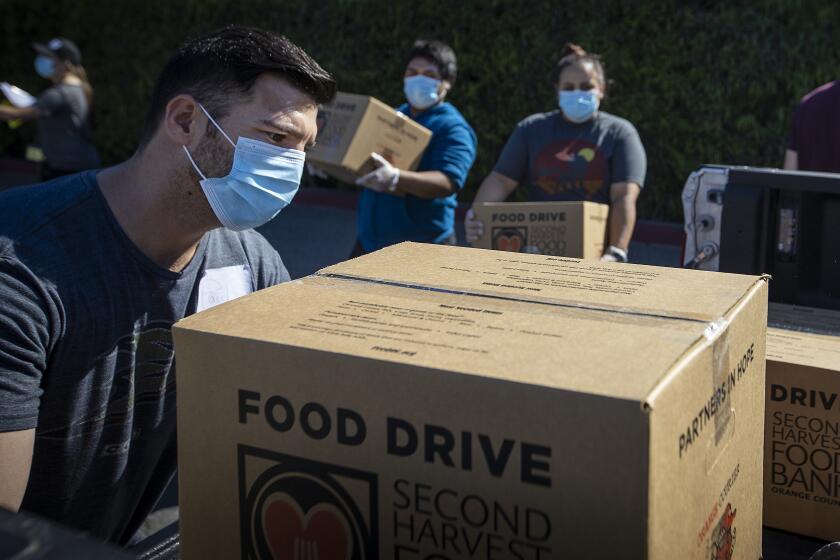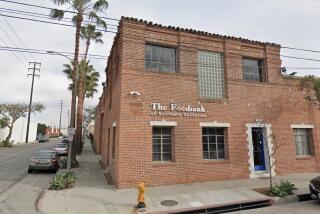27,525 pounds of carrots a day: How L.A. schools are feeding the masses
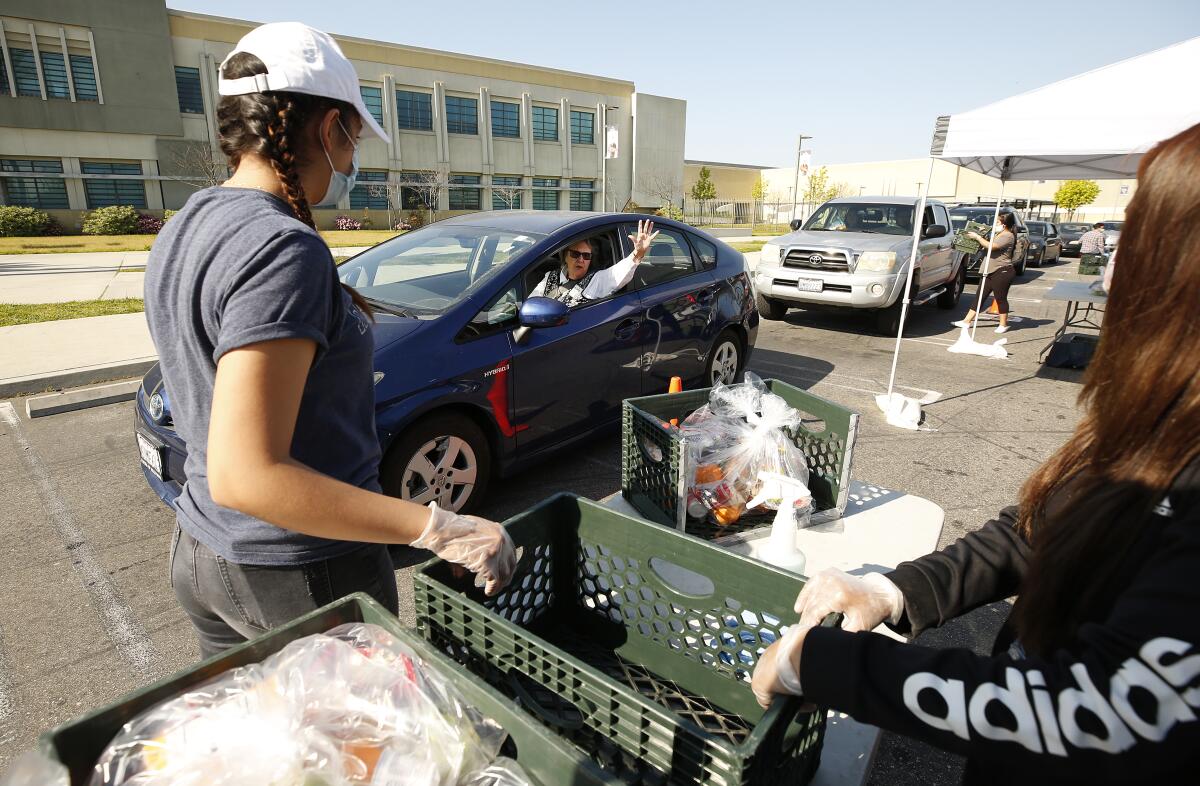
- Share via
Benjamin and Samuel Zuniga look to education to improve their future. But for now, the brothers are relying on their school district to help put food on the table.
“People are just living off what they can afford basically,” said Benjamin, who takes college classes but lost his job, as have other family members. His brother Samuel, a Venice High School junior, is the only family member who attends a Los Angeles public school. But the L.A. school district is feeding the entire six-person clan.
“Of course we take advantage of all the food giveaways,” Benjamin said. “Just thank God.”
Although campuses are closed, school districts throughout the state have taken on a critical role during the coronavirus crisis: feeding children shut in at home and paying for it with money from the federal school-lunch program. Morning drop-off lanes have been transformed into food pickup drive-throughs; school buses in rural areas leave food boxes at familiar bus stops; families stand clustered outside campuses in walk-up lines, spaced six feet apart by cones, to receive “grab and go” bags.
But the largest, perhaps most generous and financially risky school system effort in the state, if not the country, is underway at 63 campuses in the Los Angeles Unified School District, which is giving away meals not only to students, but for anyone who shows up — no questions asked, except: How many do you need?
“This is a community in crisis,” said L.A. schools Supt. Austin Beutner. “Anyone who arrives looking for food — we’re assuming needs the food — and we’re going to provide it.”
These are some of the unusual new scenes across the Southland during the coronavirus outbreak.
Since March 18, the nation’s second-largest school district has emerged as a mammoth food distribution operation, serving about 9.8 million meals so far at campuses strategically located through the school system’s broad expanse and partnering with the Red Cross and the regional food bank.
To put it in perspective, the Red Cross said it helped provide 382,100 meals and snacks in the wake of the devastating 2018 California wildfires; 4.5 million after Hurricane Harvey, which struck Texas and Louisiana in 2017; and 12.8 million that same year after Hurricane Maria ripped through Puerto Rico.
The lines grow every day as the crisis wears on, at times stretching more than half a mile. Friday was the highest meal total yet — 585,017 — putting the district on pace to far surpass 25 million by June 12, the last day of the academic year.
In Los Angeles County, all 80 schools districts are providing at least limited food service under state directives. In addition, more than 100 independently operated charter schools also are providing meals.
L.A. Unified was well-suited to mobilize — its massive food service operation already was providing about a million meals per day when campuses were open: breakfast in the classroom, lunch in the cafeteria and some take-home dinners — food that was generally hot and healthful, if sometimes uninspiring.
But this new operation posed efficiency and safety challenges for workers and families in need. On Friday at Byrd Middle School in Sun Valley, trained volunteers wore caps, gloves and masks. Some 20 people in the gym assembled meal packs while about 20 others managed walk-up traffic and a line of cars that stretched 90 deep throughout the 8-11 a.m. pickup time.
About 3,600 district workers volunteered for the effort and received a $100-per-day stipend. Prepared meal bags were set on a rear table; workers asked people how many they needed and then moved that number of bags to a front table for pickup. A separate worker then swept in with disinfectant to wipe down the front table, the touch point for families and children. Wipe. Repeat pickup. Wipe. Repeat.
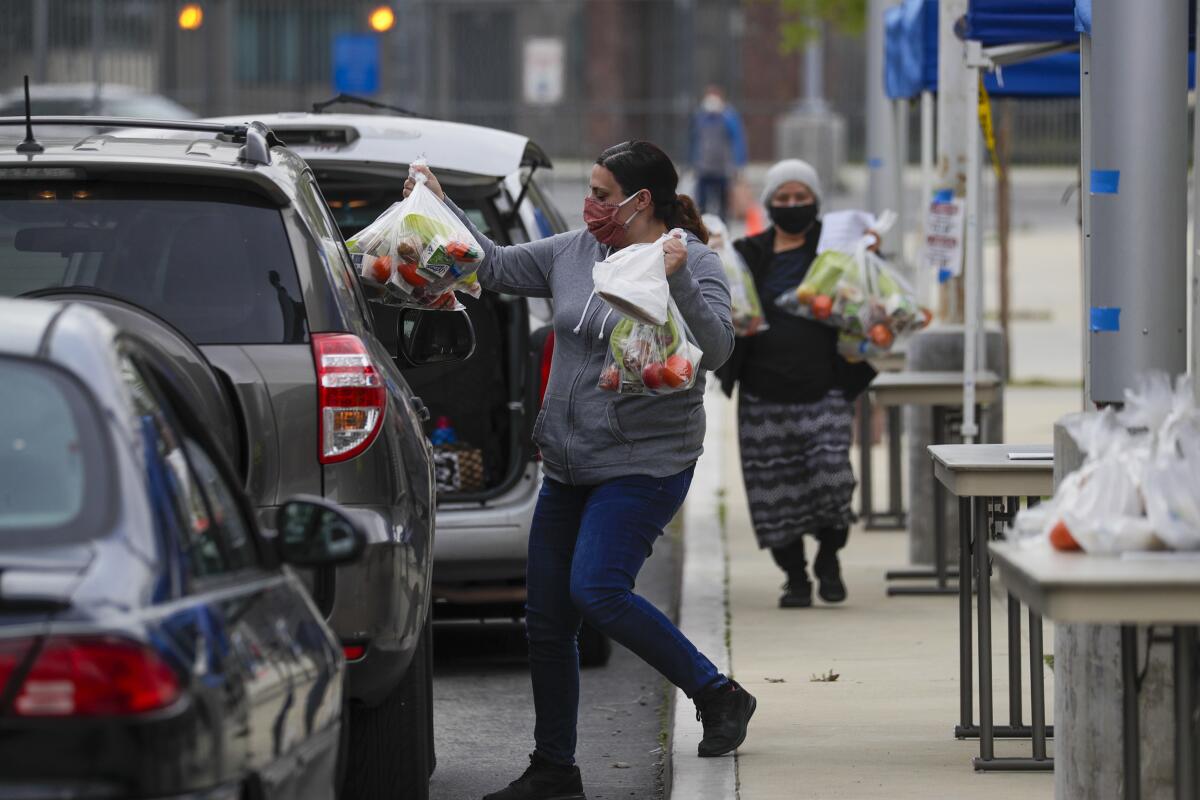
In one day more than 26,000 gallons of milk, 219,000 cereal boxes, 27,525 pounds of carrots, 50 tons of fruit and countless turkey sausages will be given away. With the exception of milk, these meals rely on “shelf-stable” ingredients that don’t spoil quickly.
The meal packers inside Byrd’s gym included teaching assistant Johanna Cifuentes, who normally helps first- and second-graders learn to read at a nearby elementary school. She wanted a way to keep helping.
Those in line have included her parents: Her father lost his job as a valet, while her mother lost her work cleaning houses.
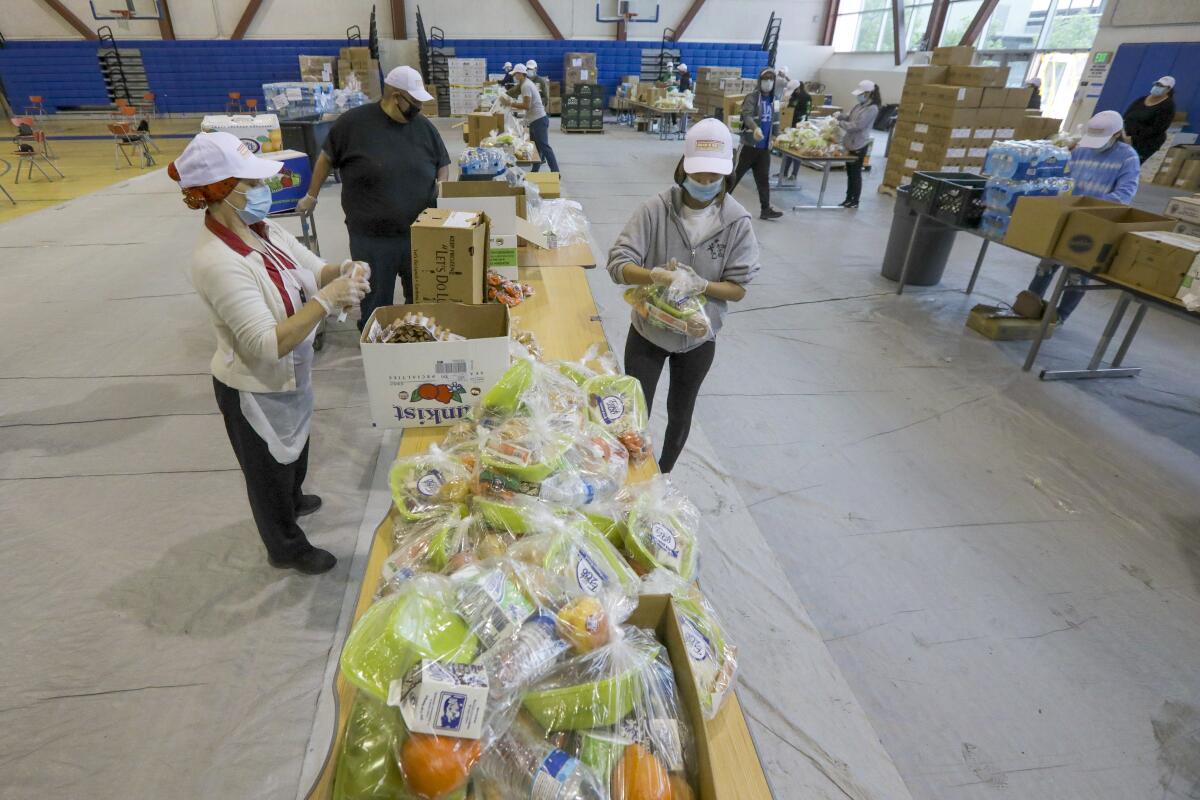
The Red Cross has provided 1,000 unpaid volunteer workers. On April 6, the Los Angeles Regional Food Bank joined in, giving out 36-pound boxes of nonperishable food — pasta, rice, soup — enough for about 30 meals. The Food Bank expects to reach 36,000 families at school sites by month’s end, having provided the equivalent of more than 1 million meals.
The effort comes amid increasing food insecurity. Nearly half of the households in Los Angeles County have lost a job or had their work hours cut, and an additional 10% have lost other sources of income because of the coronavirus pandemic, according to a recent survey.
Food banks are facing historic demand just as their supply chains have been disrupted and they are short of volunteers, said Katie Fitzgerald, chief operating officer for Feeding America, which coordinates the nation’s network of 200 regional food banks. Donors also are needed to respond to the crisis. Many markets are no longer able to donate excess food because of increased demand, while produce rots in the fields because it’s not getting to market.
In the L.A. region, the food bank system is strained, with distribution up 73% over last year and some distribution points closed, according to an update last week from the Regional Food Bank.
For now, L.A. Unified has generally been able to manage the demand.
If you have extra food, here’s how you can help local food banks or pantries. If you are struggling to buy food, this guide has information for you.
The Zunigas are grateful because their modest family income has shrunk with their job losses. The family lives in Mar Vista Gardens, a low-income housing complex, within easy walking distance of the Mar Vista Family Center, a secondary distribution point for the food being handed out at nearby Marina del Rey Middle School.
Late that morning, Yadira Mora came by with her first-grader Emily, one of three children who used to receive breakfast and lunch at school.
“The kids are at home and all they do is eat all the time,” she said, laughing.
“Everything’s amazing,” said Mora, whose husband, a gardener, has lost work during the pandemic. “Milk, chocolate milk, pancakes, sandwiches, oranges, apples. Every day when my kids wake up they’re excited to see what I got for them.”
“Sometime if I have too much, I’ll tell my neighbor: Do you want some milk? We’re helping each other out during this.”
Although she arrived before 10 a.m., the supply of meals already was exhausted, which had never happened before. The crowd may have been larger than usual because donors also were handing out free headphones to help students screen out noise while they do their schoolwork at home.
On a recent morning at South East High School in South Gate, a line of cars stretched outside the campus entrance more than a quarter-mile.
The scene was much the same at Gage Middle School in Huntington Park, where school board member Jackie Goldberg recently nudged her slightly battered Prius into the line to offer volunteers a personal thank you — from the safe distance of inside her car. She said the line of vehicles was at least 10 times as long as when the food giveaway began.
The New York City school system, the nation’s largest, has followed L.A.’s example. Its food program began about the same time as L.A. Unified, but was initially for children only and was providing about 130,000 meals a day. On April 3, the program opened to all. The district distribution has swelled to more than 250,000 meals per day. New York has a special tax levy to pay for the meals provided to adults, said spokesman Nathaniel Styer.
L.A. Unified is now racking up more than $2 million per day in food costs — nearly $39 million so far, a calculated risk. The federal government — through the Department of Agriculture — typically reimburses school districts only for feeding children who live in poverty, which describes about 80% of L.A. Unified students. Although the feds have made the policies more flexible, some rules remain in place.
To get reimbursed, the district must “ensure that meals are distributed only to parents or guardians of eligible children, and that duplicate meals are not distributed to any child,” a department spokeswoman told The Times.
Documenting the connection of meals to specific enrolled students would add enormous complications. L.A. officials presume they’re feeding adults as well as children and that the children include many from outside L.A. Unified.
Beutner said the district is doing the right thing and that he expects the government to follow suit — and not penalize L.A. Unified for feeding the hungry.
At the Mar Vista center, those lined up included Lilia Candelario, whose daughter Marlene attends a privately managed charter that is not providing food. Candelario said she’s grateful to be able to avoid crowded stores, which she sees as less safe, and to save money. She has temporarily lost her work as a nanny.
Yuliana Regalado, a second-grader at Stoner Avenue Elementary in Culver City, listed what she liked as she stood in line with her mother, saving the best for last.
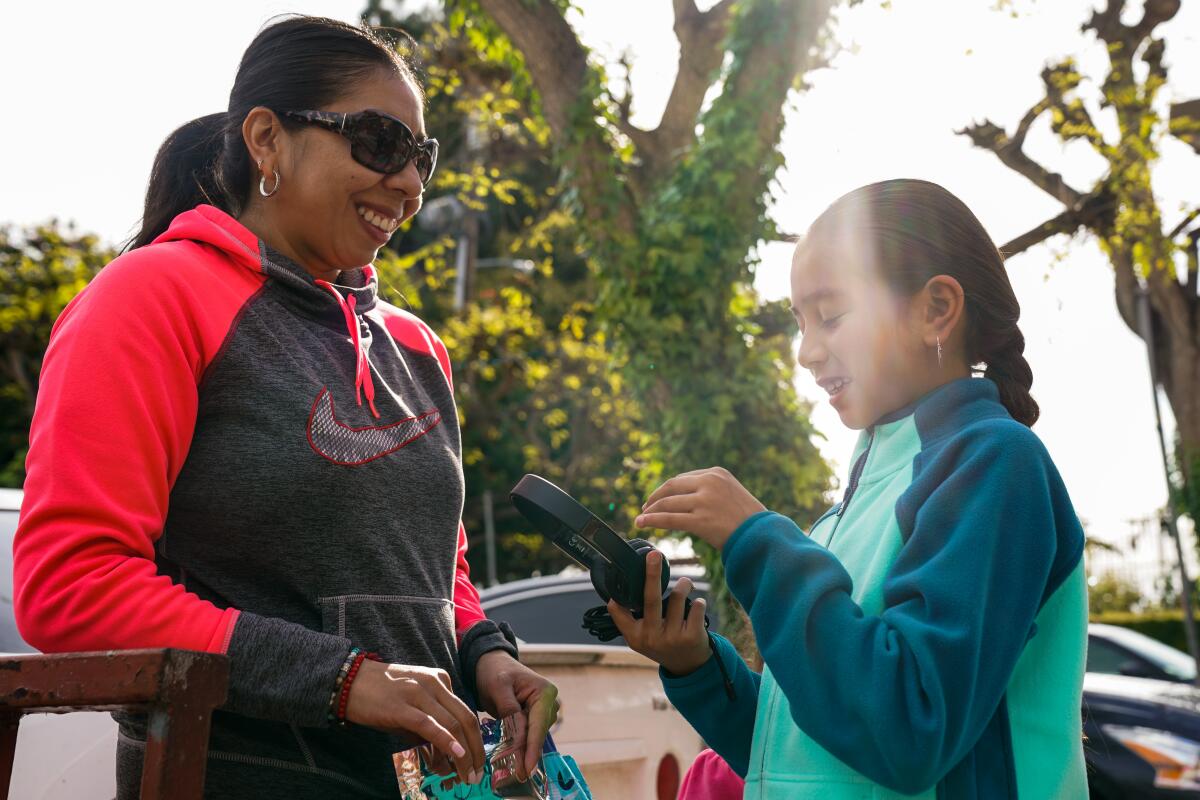
“We get milk and carrots — and coffee cakes,” she said excitedly, thinking about a treat that is probably L.A. Unified’s most famous offering. “Really good!”
More to Read
Sign up for Essential California
The most important California stories and recommendations in your inbox every morning.
You may occasionally receive promotional content from the Los Angeles Times.

